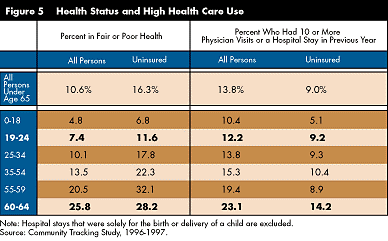
The need for health care increases substantially with age, as indicated by differences across age groups in health status and health care use. More than one-fourth of persons age 60 to 64 reported that their health was either fair or poor; this is more than three times the number of younger adults and more than five times the number of children (see Figure 5). These health patterns are similar for uninsured persons, although the health status of uninsured persons is somewhat worse than that of the general population for certain age groups.

The poorer health status of older adults is reflected in much higher rates of health care use, especially the more costly forms of use, such as frequent visits to physicians and hospital stays. Almost one-fourth of 60- to 64-year-olds had ten or more physician visits and/or a hospital stay in the previous year, compared with 12 percent of 19- to 24-year-olds and about 10 percent of children. Despite having generally poorer health, uninsured persons use significantly less health care than the general population across all age groups, which reflects the more restricted access to care among uninsured persons.